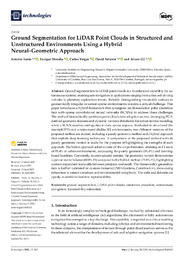Por favor, use este identificador para citar o enlazar este ítem:
https://hdl.handle.net/11000/36836Registro completo de metadatos
| Campo DC | Valor | Lengua/Idioma |
|---|---|---|
| dc.contributor.author | Santo López, Antonio | - |
| dc.contributor.author | Heredia-Aguado, Enrique | - |
| dc.contributor.author | Viegas, Carlos | - |
| dc.contributor.author | Valiente, David | - |
| dc.contributor.author | Gil, Arturo | - |
| dc.contributor.other | Departamentos de la UMH::Ingeniería de Sistemas y Automática | es_ES |
| dc.date.accessioned | 2025-07-11T09:42:34Z | - |
| dc.date.available | 2025-07-11T09:42:34Z | - |
| dc.date.created | 2025-04-16 | - |
| dc.identifier.citation | Technologies 2025, 13(4), 162 | es_ES |
| dc.identifier.issn | 2227-7080 | - |
| dc.identifier.uri | https://hdl.handle.net/11000/36836 | - |
| dc.description.abstract | Ground segmentation in LiDAR point clouds is a foundational capability for autonomous systems, enabling safe navigation in applications ranging from urban self-driving vehicles to planetary exploration rovers. Reliably distinguishing traversable surfaces in geometrically irregular or sensor-sparse environments remains a critical challenge. This paper introduces a hybrid framework that synergizes multi-resolution polar discretization with sparse convolutional neural networks (SCNNs) to address these challenges. The method hierarchically partitions point clouds into adaptive sectors, leveraging PCAderived geometric features and dynamic variance thresholds for robust terrain modeling, while a SCNN resolves ambiguities in data-sparse regions. Evaluated in structured (SemanticKITTI) and unstructured (Rellis-3D) environments, two different versions of the proposed method are studied, including a purely geometric method and a hybrid approach that exploits deep learning techniques. A comparison of the proposed method with its purely geometric version is made for the purpose of highlighting the strengths of each approach. The hybrid approach achieves state-of-the-art performance, attaining an F1-score of 95.4% in urban environments, surpassing the purely geometric (91.4%) and learningbased baselines. Conversely, in unstructured terrains, the geometric variant demonstrates superior metric balance (80.8% F1) compared to the hybrid method (75.8% F1), highlighting context-dependent trade-offs between precision and recall. The framework’s generalization is further validated on custom datasets (UMH-Gardens, Coimbra-Liv), showcasing robustness to sensor variations and environmental complexity. The code and datasets are openly available to facilitate reproducibility | es_ES |
| dc.format | application/pdf | es_ES |
| dc.format.extent | 22 | es_ES |
| dc.language.iso | eng | es_ES |
| dc.publisher | MDPI | es_ES |
| dc.rights | info:eu-repo/semantics/openAccess | es_ES |
| dc.rights | Attribution-NonCommercial-NoDerivatives 4.0 Internacional | * |
| dc.rights.uri | http://creativecommons.org/licenses/by-nc-nd/4.0/ | * |
| dc.subject | ground segmentation | es_ES |
| dc.subject | LiDAR point clouds | es_ES |
| dc.subject | annotation procedure | es_ES |
| dc.subject | autonomous navigation | es_ES |
| dc.subject | traversability estimation | es_ES |
| dc.subject.other | CDU::62 - Ingenieria. Tecnología | es_ES |
| dc.title | Ground Segmentation for LiDAR Point Clouds in Structured and Unstructured Environments Using a Hybrid Neural–Geometric Approach | es_ES |
| dc.type | info:eu-repo/semantics/article | es_ES |
| dc.relation.publisherversion | https://doi.org/10.3390/technologies13040162 | es_ES |

Ver/Abrir:
technologies-13-00162-v2.pdf
7,3 MB
Adobe PDF
Compartir:
 La licencia se describe como: Atribución-NonComercial-NoDerivada 4.0 Internacional.
La licencia se describe como: Atribución-NonComercial-NoDerivada 4.0 Internacional.
.png)